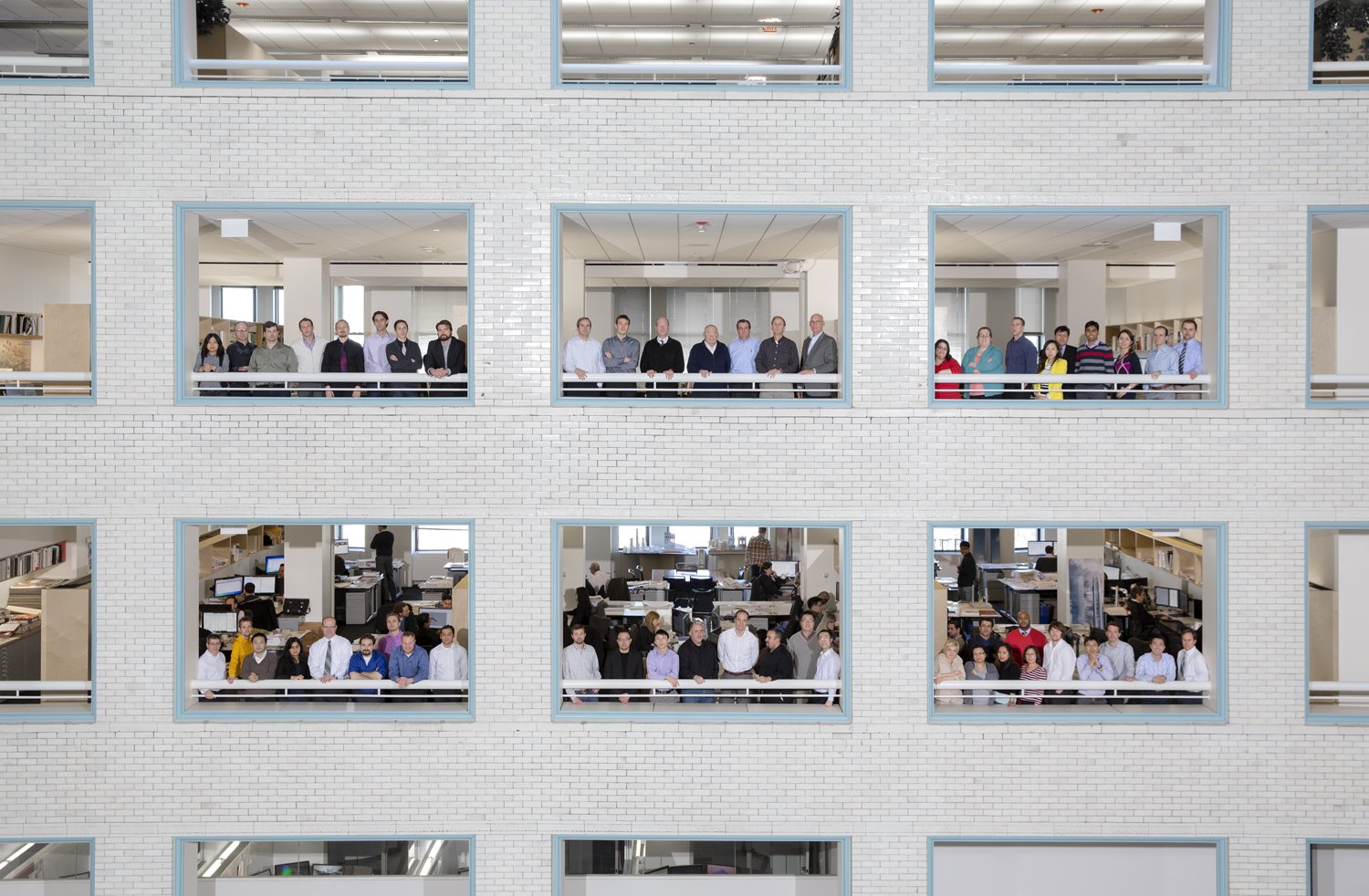
March 11, 2014
The Team Maintaining SOM’s Legacy of Engineering Greatness
Led by Bill Baker, the engineering team at SOM Chicago is reshaping the form and function of buildings.

For a relatively large practice, SOM Chicago rarely feels like one. Pictured here are the several dozen architects and engineers that make up the firm, including representatives from two in-house groups: the Chicago Structures Group and so-called “Research Gang,” under the direction of “maker” Bill Baker.
Photography by Tim Klein, unless otherwise noted.
Frank Lloyd Wright called them the “Three Blind Mies.” Louis Skidmore, Nathaniel Owings, and John O. Merrill were the architectural troika whose namesake firm—founded in Chicago in the mid-1930s—became something like the Julia Child of postwar design, delivering European sophistication to middle America at midcentury. Through hundreds of buildings in cities all across the country (and, later, around the world) the office turned the stringent aesthetic of German master builder Ludwig Mies van der Rohe into an architectural metonym for big business. Whether you look at rows of sleek glass skyscrapers and see grace and economy, or only the “thousand blind windows” of Allen Ginsberg’s monstrous “Moloch,” it’s no stretch to say that you have Skidmore, Owings & Merrill (SOM) to thank for them.
But while its founding partners—to say nothing of Mies and Wright—are all long gone, SOM as a force on the design scene remains strong. The firm’s acronym has always been better known than the men behind it. “It’s a group practice, an assemblage of architects and engineers,” says John Zils, a structural engineer who’s been with SOM since 1966. “That was the concept of the firm when it started.” What’s sustained SOM through nearly eight decades isn’t the spirit of its progenitors, but its ability to attract an extraordinary roster of talent—a succession of prominent engineers and designers who’ve guided it through the changing currents of the architecture world. From the 1950s, when design partner Gordon Bunshaft first brought the International Style to New York with his scheme for Lever House, to the 1970s, when engineer Fazlur Rahman Kahn’s Sears Tower snatched the title of world’s tallest building, SOM’s assorted animating geniuses have shaped not only the face of the firm, but the development of architecture in our time.
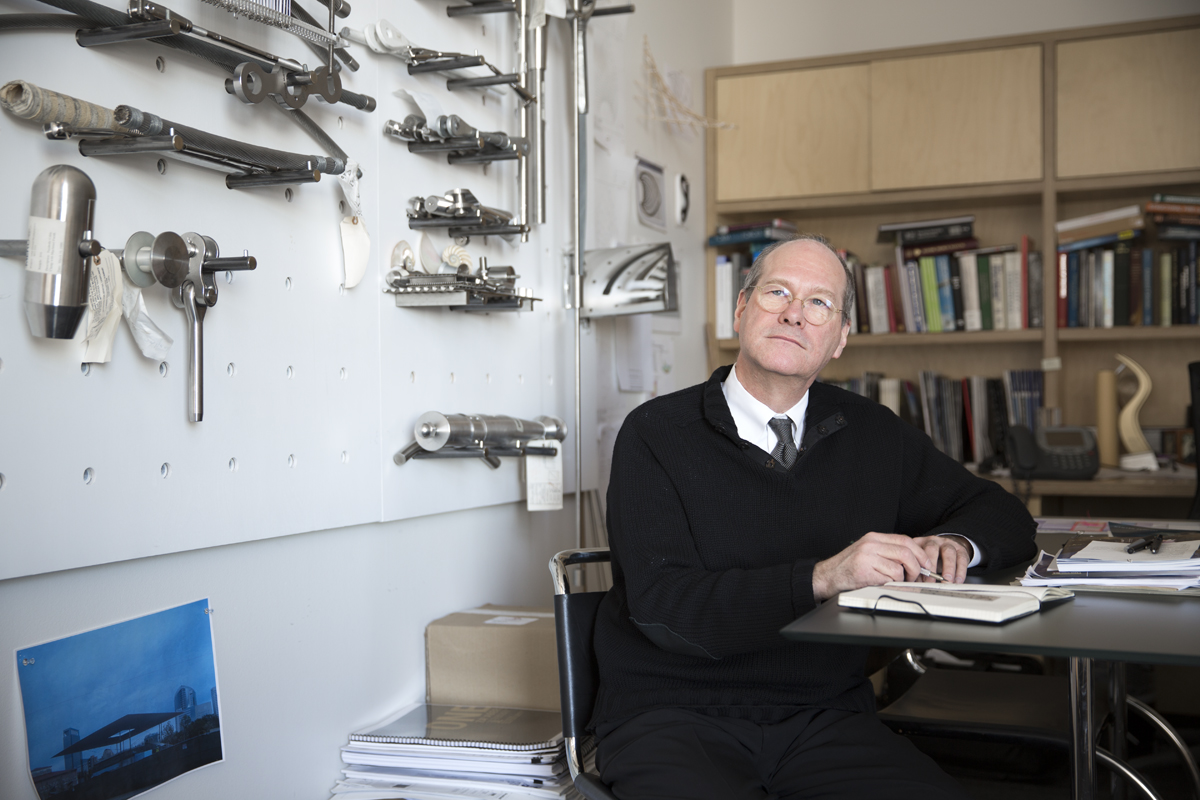
The structural and civil engineer Bill Baker in his office at SOM Chicago. Baker is considered the “leading light” of the firm.
The heir to that line today is William F. Baker, SOM structural and civil engineering partner—and in many ways the guiding light of the flagship Chicago office—the man whose buttressed-core concept made possible Dubai’s Burj Khalifa, the current global record holder for building height. The unassuming, bespectacled, 60-year-old Baker hails from a small town in Missouri and projects a slightly rarefied Midwestern sensibility, his plainspoken modesty spiked with wonkish enthusiasm for structural esoterica. “Bill is obsessed with truth and purity in the design process,” says Mark Nagis, an architect at the firm. “In order for Bill to be satisfied with a project, it has to be completely clear.” Expounding on Michell trusses, awning systems, the form of a nautilus shell and the science of wind tunnels, Baker makes engineering seem less a matter of nuts-and-bolts precision and more a speculative, adventurous endeavor. “Engineering is an evolving profession,” Baker says. “People think we’re done, but we’re a long way from done. What’s the optimal shape for a bridge? We’re still trying to discover that.”

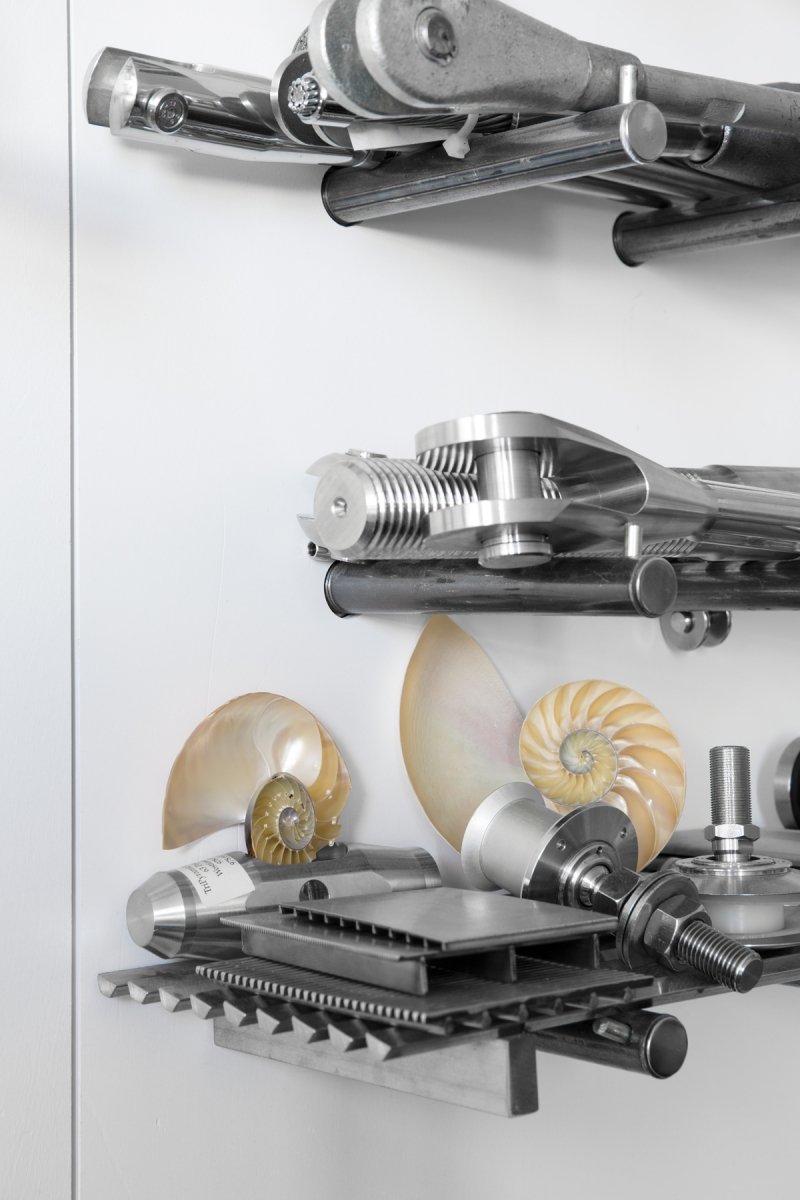
Bill Baker and his colleagues in SOM Chicago keep their offices like mini museums—stacked with papers, models, drawings, renderings, and prototypes. Each space is open to the main floor, inviting staffers to stop in and see what’s up.
The process of discovery is one in which Baker and his senior colleagues have managed to enlist practically every employee of SOM Chicago’s 300-plus staff. Encompassing architects, structural and MEP engineering, urban planners, interior designers, and sustainability experts, Baker’s team is a multidisciplinary crew that strives to work as a single organic entity. The practice’s three floors in the historic, Daniel Burnham–designed Railway Exchange Building—on South Michigan Avenue across from Grant Park—ring around a central atrium, unencumbered by dividing walls, making it possible to see nearly every workstation from any point near the ledge. Walking through the space, Baker points out the purpose-built shelving system and small “kindergarten tables” that allow users to change the interior layout at will, creating different arrangements for different work groups. “It’s pretty fluid here,” Baker explains. “Everyone at every level talks to everyone at every level.”
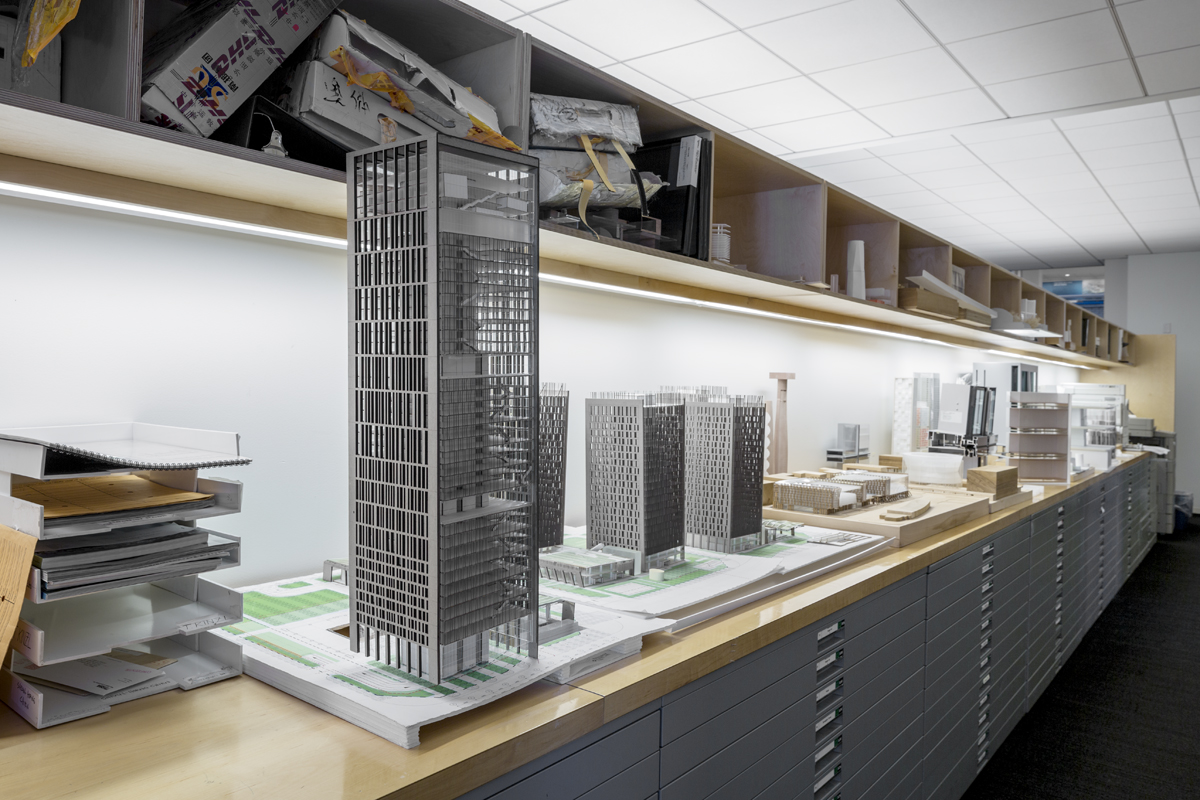
A row of models that lines the shelves of the SOM Chicago office.
For a relatively large practice, SOM Chicago rarely feels like one. When a lunch meeting lets out early in one of the conference rooms upstairs, employees on the lower level are quick to spot the leftovers as they’re being carted out to reception, and arrive instantly to glean the remains of the quinoa salad.
Along with his fellow partners, Baker is eager to keep things this way, pointing out that the firm has been careful not to over-hire or spread itself too far on the vertical axis into areas like real estate development or construction management. “That’s been an active and ongoing discussion,” says the engineer. “But we think it distracts from focusing on design.” The less-is-more ethic is certainly in line with the firm’s Miesian heritage, but it may come as something of a surprise to longtime observers. SOM’s reputation, after all, is as an architectural behemoth, a factory that turns out buildings on a massive scale using a corporate business model mirroring its corporate clientele. This view isn’t altogether unjustified. Seen in combination with its ten offices in five countries on three continents, SOM is indeed huge, capable of working on dozens of projects at once. Being the namesake of three somewhat obscure (and, by now, very dead) people doesn’t help, and the collaborative spirit that’s kept an engineer like John Zils on board for nearly his entire career can sometimes make it appear from the outside that the firm lacks a unifying identity. No one in the office even knows for certain how many projects SOM has completed in its 78-year history (though they estimate more than 10,000).

ROCHE DIAGNOSTICS TRAINING CENTER, INDIANAPOLIS 2014
Currently under construction, the building expands on the Swiss pharmaceutical company’s Indianapolis campus, with a vast first-floor “super-lab” and adjoining seminar rooms above. The 87,000-square-foot project has a number of sustainable features, including chilled beams, radiant panels, and raised floors for electrical and mechanical services.
Courtesy SOM
How to maintain cohesion in such a vast operation? For SOM today, what keeps the office’s disparate parts working in concert comes down to three terms, repeated again and again by Baker, which design director Eric Keune writes on a piece of paper and thumps emphatically with his pencil as he explains them: “Simplicity. Structural Clarity. Sustainability.”
“The ideas are so broad that anyone can interpret them in any way they want,” Keune says. “Yet each one represents an idea, a phenomenon.” Using these watchwords as a “cudgel,” the architect says, SOM can steer clear of design “outliers” and preserve a certain consistency across the typological spectrum. However abstract, Baker’s broad-stroke principles not only work their way into SOM’s design process, but are manifested in the way the office’s projects actually look, constituting what Keune’s architect colleague Lucas Tryggestad calls “a visual ethic.”

TIANJIN RAIL STATION TIANJIN, CHINA TBD
Rush hour will see 6,000 commuters strolling under the latticed roof (two views of the model are shown) of the Tianjin rail station, its veiny, web-like pattern looking just like some of the force diagrams that decorate Baker’s office wall. And that’s basically what it is: Its parabolic trusses radiate out- ward in accordance with Maxwell’s load path theorem.
Courtesy Crystal CG/SOM
In Tianjin, China, the firm broke ground in 2012 on the Tianjin CTF Finance Centre tower, which, at 1,740 feet, will be among the world’s tallest buildings (though well short of the Burj). The structure’s tapering profile and flanged, white-trimmed sides lend it a passing resemblance to one of the United States’ now-retired space shuttles, and that aerodynamic quality is a testament to the intensive trial-and-error experimentation that produced the design. SOM’s innovative use of wind-tunnel technology has helped it discover new ways of bracing tall buildings, and CTF’s unique form will help cut down on the swirling eddies of air that often buffet the biggest skyscrapers. Giving a design that kind of emphatic structural legibility—while still accommodating a complex program—means bringing all of SOM’s departments into the process nearly at the same time. Engineer Brad Young says both his colleagues and their architectural counterparts “typically get involved at the earliest possible stage,” and there’s room for even some of the firm’s youngest associates to get involved, as 28-year-old engineer Matthew Parkolap did for CTF. With the firm for just three years, he helped coordinate the MEP and structural requirements of the building, and says the experience gave him “a more holistic view” of how SOM works. So synchronous is the firm’s design process on a big commission like Tianjian that, Baker jokes, “by the time it’s completed, everyone will think it’s theirs.”
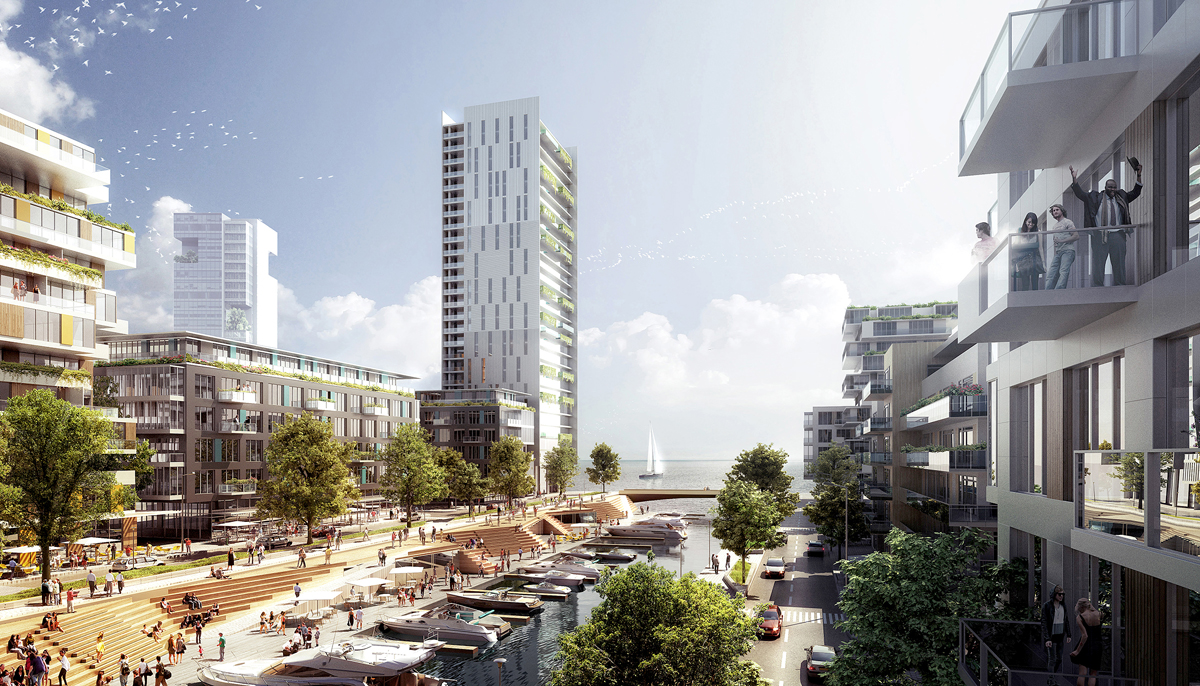
CHICAGO LAKESIDE 2040
No one’s quite certain when Chicago Lakeside will be complete, but the project is one near and dear to the whole SOM staff: Chicago, after all, is the firm’s hometown, with dozens of projects all over the city. Located on the former site of a massive U.S. Steel plant, Lakeside will eventually be home to between 13,000 and 15,000 residents. The project was featured as a Metropolis Game Changer in 2013.
Courtesy MIR/SOM
Another upcoming SOM project that bears out the firm’s process and principles is a planned mixed-use community on the south side of Chicago. Situated on a massive 600-acre site formerly occupied by a major U.S. Steel mill, Chicago Lakeside sits right on the banks of Lake Michigan, and when complete will reunite a languishing urban neighborhood to the west with the scenic waterfront. “It’s the scale of a city,” explains Douglas Voigt, SOM’s director of urban design and planning, and he and his collaborators in the sustainability field have created a “net-positive water scenario” that will put more water back into the lake and a comprehensive electrical “micro-grid” that will maximize energy efficiency. The project is still many years from completion—and contingent upon numerous political and financial issues—but even at this early date the other members of the SOM team are already starting to find ways to bring in the structural and formal integrity that will round out the ecological component. “We’ve worked with Bill and his team to understand how you build within this context, and we’ve been able to find ways to innovate,” Voigt says. “There might even be a new way to develop here.” The blank-slate site, with its treacherous, landfill-based substrate, could make it the perfect proving ground for some of the more daring new structural proposals emerging from Baker’s engineering contingent.
One such proposal Voigt mentions is the Timber Tower, a speculative building system first advanced by SOM engineer Ben Johnson and developed in collaboration with firm-wide practice manager Dave Horos. A 42-story tower, 80 percent of which is composed of wooden members, the concept may seem just a nifty thought exercise. But with Baker’s encouragement, efforts are underway to build a demonstration model sometime in the next several years. Lightweight, strong, and carbon sequestering, the idea of a high-rise in lumber is exactly the kind of out-of-the-box solution Baker encourages his fellow engineers and architects to seek out. “Bill just has that curiosity,” says architect Arathi Gowda, who’s seen it firsthand in her work with Sustainable Engineering Studio staff. But it’s among his fellow engineers that Baker really gives free rein to his structural imagination. Once a week, he leads a mixed crowd of mostly younger colleagues he calls the “Research Gang.” Not quite a lecture series, but more like ricocheting digressions organized around a notional theme, the Research Gang meetings wander from abstruse mathematical formulae to architectural anecdotes and back again. It’s emblematic of Baker’s whole managerial style. “Bill runs the engineering side like an academic undertaking,” Keune says.
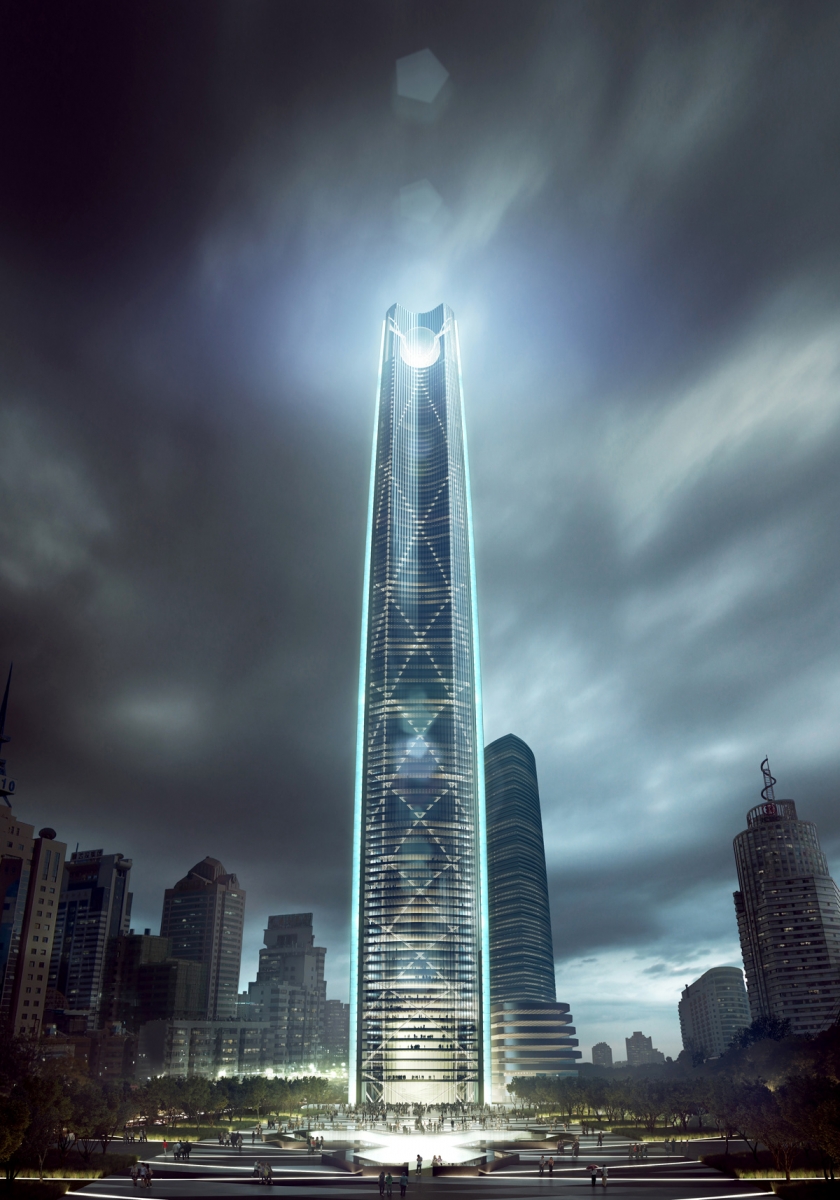
KUNMING JUNFA DONGFENG SQUARE
KUNMING, CHINA 2018
The 456-meter tower has a robust structural system that responds to the highly seismic province of Yunnan, in southwest China. SOM engineers have devised a system with three “mega-columns” around the periphery.
Courtesy SOM
During a recent session, Baker punctuates his lesson with stories of SOM lore. When Chicago’s famous John Hancock Center was being built, he says, the builders discovered the caissons weren’t laid right, and the structure might have collapsed but for a canny surveyor. (There were problems with the construction methods used by the contractor for pouring the caissons. An SOM engineer discovered it during a routine surveying of the building.) Returning to his main subject, Baker works through an equation, which he first happened upon as a young engineer, for calculating structural deflection. His solution, he explains, did away with a lot of the smaller, chunkier arithmetic an engineer would otherwise have to perform. “If you do have to do all that, you just end up a technician,” he says.
The way he uses that word as a pejorative seems to indicate the direction Baker wants his team to go—away from the rote and staid, toward the artful and expressive. “One doesn’t invent a new architecture every Monday morning,” Mies once famously said—and certainly what Baker and company appear to be doing isn’t that. As compared to sometime architect collaborators like Frank Gehry and artists like James Turrell, SOM seems content not to develop too definite a set of formal or conceptual signatures, even if that exposes it to criticism for being too bland or commercial. But the earnestness of Baker’s inquisitive pragmatism—and his colleagues’ singular ability to act together in that spirit—are what’s helped the office to adapt and thrive in an era as different from the modernist reductivism of its early years as from the postmodernist interval of the last couple of decades of the twentieth century. With so many younger studios today looking to establish durable, collaborative practices not overly dependent on stylistic branding, it’s curious to think that perhaps they could do worse than to look to one of the biggest and best-known brands of them all.





